Proton acceleration is really a secondary effect of laser bombardment. Initially, the laser expels out electrons from the thin solid target. Moving close to the speed of light, these electrons then create a powerful electric field, known as a sheath field, and it is this that accelerates the nearby protons.
However, the method of proton acceleration has been widely studied in the past two decades, bringing the field close to applications, such as proton therapy, probing of electric fields, isochoric heating or inertial confinement fusion.
Target normal sheath acceleration (TNSA) has been the most investigated method among all, due to its relatively simple experimental implementation and the moderate laser intensity it requires. However, even with the continuous increase in the available laser power, the limited scaling of the maximum energy of the accelerated protons with the laser energy has a major drawback for many applications.
In a new study by the Sweden’s Chalmers University of Technology and the University of Gothenburg, scientists modified the TNSA scheme. They have developed a new method to double the energy of a proton beam produced by laser-based particle accelerators.

CREDIT
Mia Halleröd Palmgren/Chalmers University of Technology
The standard approach involves firing a laser pulse at a thin metallic foil, with the interaction resulting in a beam of highly charged protons. In this new method, scientists primarily split the laser into two less intense pulses, before firing both at the foil from two different angles simultaneously. When the two pulses collide on the foil, the resultant electromagnetic fields heat the foil extremely efficiently. The technique results in higher energy protons whilst using the same initial laser energy as the standard approach.
Julien Ferri, a researcher at the Department of Physics at Chalmers, and one of the scientists behind the discovery said, “This has worked even better than we dared hope. The aim is to reach the energy levels that are actually used in proton therapy today. In the future, it might then be possible to build more compact equipment, just a tenth of the current size, so that a normal hospital could be able to offer their patients proton therapy.”
The one of a kind advantage of proton treatment is its accuracy in targeting cancer cells, killing them without harming healthy cells or organs close by. The technique is subsequently critical for treating deep-seated tumors, situated in the brain or spine, for instance. The higher energy the proton beam has, the further into the body it can enter to battle cancer cells.

CREDIT
Johan Bodell/Chalmers University of Technology
Although the researchers’ achievement in doubling the energy of the proton beams represents a great breakthrough, the end goal is still a long way off.
Tünde Fülöp, Professor at the Department of Physics at Chalmers said, “We need to achieve up to 10 times the current energy levels to really target deeper into the body. One of my ambitions is to help more people get access to proton therapy. Maybe that lies 30 years in the future, but every step forward is important.”
“We are now looking at several ways to further increase the energy level in the proton beams. Imagine focusing all the sunlight hitting the Earth at a given moment onto a single grain of sand – that would still be less than the intensity of the laser beams that we are working with. The challenge is to deliver even more of the laser energy to the protons.”
The study is published in the journal Communications Physics.
